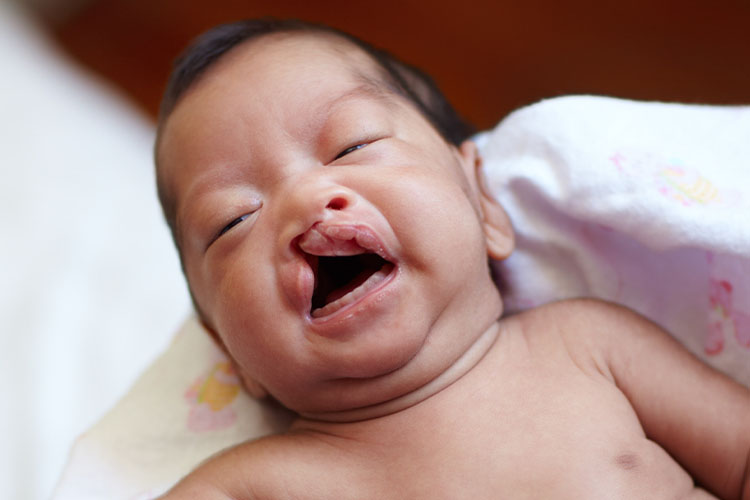Overview
Cleft lip and cleft palate are congenital conditions that occur when a baby’s lip or mouth does not form properly during pregnancy. A cleft lip appears as a gap or split in the upper lip, while a cleft palate involves a similar split in the roof of the mouth. These conditions can occur separately or together and vary in severity. Clefts develop early in pregnancy when the facial tissues that form the lip and palate fail to fully fuse.
The effects of cleft lip and palate can go beyond physical appearance. Infants with these conditions may have difficulty feeding due to challenges with suction and milk intake. Speech development can also be affected, leading to nasal-sounding speech or difficulty pronouncing certain sounds. Additionally, the gap in the palate can increase the risk of ear infections and hearing problems, as it can interfere with the function of the eustachian tube. Dental issues, such as misaligned teeth or missing teeth near the cleft area, are also common.
Treatment for cleft lip and palate involves a team of specialists and typically includes surgery to repair the cleft. Surgery for a cleft lip is often performed when the baby is 3 to 6 months old, while cleft palate repair is usually done between 6 and 18 months of age. Additional surgeries may be required as the child grows, especially for dental or speech corrections. Alongside surgical repair, speech therapy, orthodontics, and hearing assessments are critical components of treatment.
With timely and comprehensive care, children born with cleft lip and palate can achieve significant functional and aesthetic improvements. Early intervention and access to specialized medical teams can ensure that the child grows up with minimal long-term complications, allowing them to lead healthy and fulfilling lives.
Table of Contents
When to See a Doctor
It is important to seek medical attention promptly if your child is born with or suspected to have a cleft lip or palate. Early evaluation by a healthcare professional ensures timely intervention and access to specialized care.

Signs to see a doctor:
- At birth or shortly after. If the cleft is visible at birth, it’s crucial to consult a pediatrician immediately. They can guide you toward a team of specialists, including plastic surgeons, speech therapists, and nutritionists, for comprehensive care.
- Difficulty feeding. Infants with cleft palate may struggle with feeding due to challenges in creating suction. If your baby shows signs of poor weight gain, frequent choking, or milk leaking through the nose, seek medical advice right away.
- Speech and language delays. If your child has difficulty forming words or develops nasal-sounding speech, a speech therapist or cleft care team can provide evaluation and therapy tailored to their needs.
- Frequent ear infections or hearing loss. Children with cleft palate are at higher risk for middle ear infections, which can lead to hearing issues. Regular hearing assessments and early treatment are necessary if infections occur frequently.
- Dental or orthodontic concerns. If you notice irregularities in your child’s teeth alignment or missing teeth near the cleft, consult a pediatric dentist or orthodontist to address these issues as part of the overall treatment plan.
Prompt consultation with a medical professional ensures that the child receives coordinated care from a multidisciplinary team. This early intervention not only improves outcomes but also minimizes the challenges associated with feeding, speech, and overall development.
What Type of Doctor to Seek
For cleft lip and palate, a multidisciplinary team approach is essential to provide comprehensive care. The primary specialist involved is a plastic or reconstructive surgeon, who performs the surgical procedures needed to repair the cleft and restore the child’s appearance and functionality. Pediatricians often serve as the first point of contact and coordinate care, referring families to specialized teams.
Additional specialists include a speech therapist to assist with language development and address speech challenges caused by the cleft palate. A pediatric dentist and orthodontist play key roles in managing dental issues, such as misaligned or missing teeth. An otolaryngologist (ENT specialist) evaluates and treats ear infections and hearing concerns, which are common in children with cleft palate. For emotional and social support, a psychologist or counselor may also be part of the care team, helping families navigate the emotional challenges associated with the condition. This coordinated approach ensures the child receives the best possible care at every stage of development.
What to Expect from Your Visit to a Doctor
When visiting a doctor for cleft lip and palate, the initial consultation will typically involve a comprehensive evaluation of your child’s condition. The doctor will examine the cleft, assess its severity, and discuss its impact on feeding, speech, hearing, and dental health. They may take photographs, X-rays, or scans to better understand the cleft’s structure and plan the appropriate course of treatment. If your child is experiencing feeding difficulties, the doctor may recommend specialized feeding bottles or techniques to ensure proper nutrition while preparing for surgery.
During the visit, the doctor will outline a treatment timeline, including the timing of surgeries and the involvement of other specialists, such as speech therapists or orthodontists. They will discuss any potential challenges and the expected outcomes of each procedure. Parents are encouraged to ask questions about recovery, follow-up care, and long-term management to fully understand the treatment process. This visit also provides an opportunity to connect with a multidisciplinary cleft care team, which will guide the child’s care from infancy through adolescence to address all aspects of their development and well-being.
Cleft Lip and Palate Treatment Options
Cleft lip and palate can be effectively treated through a combination of surgeries and follow-up therapies tailored to the child’s needs. Timely intervention not only restores physical appearance but also ensures proper functionality in feeding, speaking, and hearing. Below is a comprehensive list of treatment options for cleft lip and palate:

Surgical Interventions
- Cleft lip repair. This surgery is typically performed when the child is 3 to 6 months old. The surgeon closes the gap in the lip by making precise cuts and stitching the tissues together. If the cleft affects the nose, nasal reshaping may also be done during the same procedure.
- Cleft palate repair. Performed around the age of 9 to 18 months, this surgery involves closing the gap in the roof of the mouth. It restores the palate’s functionality, helping the child eat, speak, and breathe more effectively. Cleft lip and cleft palate repairs are usually conducted as separate procedures.
- Ear tube surgery. Children with cleft palate often experience fluid buildup in the middle ear, leading to hearing issues. Small tubes are inserted into the eardrum to drain fluid and prevent infections, safeguarding the child’s hearing.
- Reconstruction surgery. For improved aesthetics and functionality, reconstruction surgery can be done to refine the lips, nose, or palate as the child grows. This procedure reduces visible scarring and improves facial symmetry.
Post-Surgical Therapies and Treatments
- Feeding strategies. After surgery, children may need special feeding tools such as customized bottles or nipples to ensure proper nutrition while their mouths heal.
- Speech therapy. Speech therapists help children develop proper language skills, focusing on tongue movement and pronunciation, which may be challenging for children with repaired clefts.
- Orthodontic adjustments. Dentists or orthodontists assess and correct the alignment of teeth and jaw development. Braces or other orthodontic treatments may be needed to address bite issues or misaligned teeth.
- Hearing aids. Children recovering from cleft palate surgery may require hearing aids if hearing loss persists. These devices ensure that auditory development remains on track.
- Psychological support. A psychologist can help children cope with the stress of multiple surgeries and social challenges. Emotional support from family members is equally crucial to the child’s confidence and well-being.
Treatment for cleft lip and palate often involves a team of specialists, including surgeons, pediatricians, speech therapists, orthodontists, and psychologists. This multidisciplinary approach ensures the child receives comprehensive care. With proper treatment and support, children with cleft lip and palate can lead healthy, fulfilling lives.
Cleft Lip and Palate Prognosis
The prognosis for children with cleft lip and palate is generally excellent, especially with timely intervention and a comprehensive treatment plan. Surgical repairs and post-operative therapies significantly improve physical function, appearance, and overall quality of life. Below is an overview of the expected outcomes for each treatment option:
- Cleft lip repair. This surgery provides immediate aesthetic and functional improvements, allowing the child to feed and speak more effectively. Scarring is usually minimal and can be further refined with reconstruction surgery if needed.
- Cleft palate repair. Successful repair restores the palate’s ability to assist in feeding, speaking, and breathing. Most children see dramatic improvements in their speech and eating capabilities after surgery.
- Ear tube surgery. This procedure effectively reduces the risk of hearing loss and recurrent ear infections, supporting healthy auditory development.
- Reconstruction surgery. Follow-up surgeries enhance facial symmetry and reduce visible scars, boosting the child’s self-confidence and overall appearance.
- Speech therapy. With consistent therapy, most children develop clear and understandable speech, minimizing any long-term communication challenges.
- Orthodontic adjustments. Correcting dental alignment ensures proper bite and tooth functionality, reducing the risk of future dental complications.
- Hearing aids. Hearing devices improve auditory perception and language development for children who continue to experience hearing challenges after surgery.
- Psychological support. Emotional and psychological support helps children navigate social challenges and medical procedures, improving their overall mental well-being and resilience.
With proper care, children with cleft lip and palate can achieve normal physical, social, and emotional development. Early intervention, ongoing support, and regular follow-ups with a multidisciplinary team ensure the best possible outcomes for the child’s health and quality of life.


